
We travel in a campervan through Albania en route from Greece to Montenegro and Croatia on our winter camper trip, and it was a great way to see the country of scenic roads, beautiful beaches and quite widely spaced historic sites. During our road trip, we learnt a lot about Albania. Below you can read interesting facts about Albanian cites, history, government, superstitions and many more.
Facts about Albania
Where is Albania?
Albania is located in south-eastern Europe running north-south along the Adriatic Sea, immediately north of Greece making it the southernmost of the Balkan states.
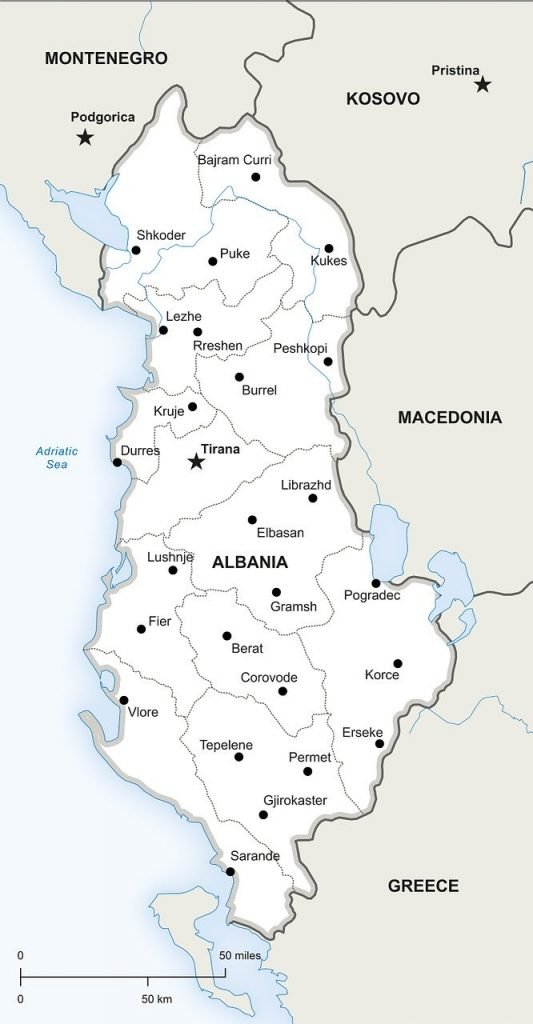
Albania Names
Albania is our name for the nation known in its own language as Shqipëri. Its official international name is the Republic of Albania.
Albania nickname is the Land of the Eagles. Read about other Countries Nicknames.
Albanian Facts Population
Most Albanians live somewhere else. The combined Albanian populations of the United States, Italy, Germany, Switzerland, Sweden, Greece, Turkey, and other Balkan states outnumber Albanians living in Albania. The ratio is about 3:1 with three million living in Albania and perhaps as many as ten million living abroad.
The biggest amount of Albanians in Albania lives in Tirana, which is the capital city.
Albanian National Symbol
The Eagle is the national and ethnic symbol of Albania. The Eagle appears in a stone carving dating from 1190, and there is a two-headed eagle on the national flag.
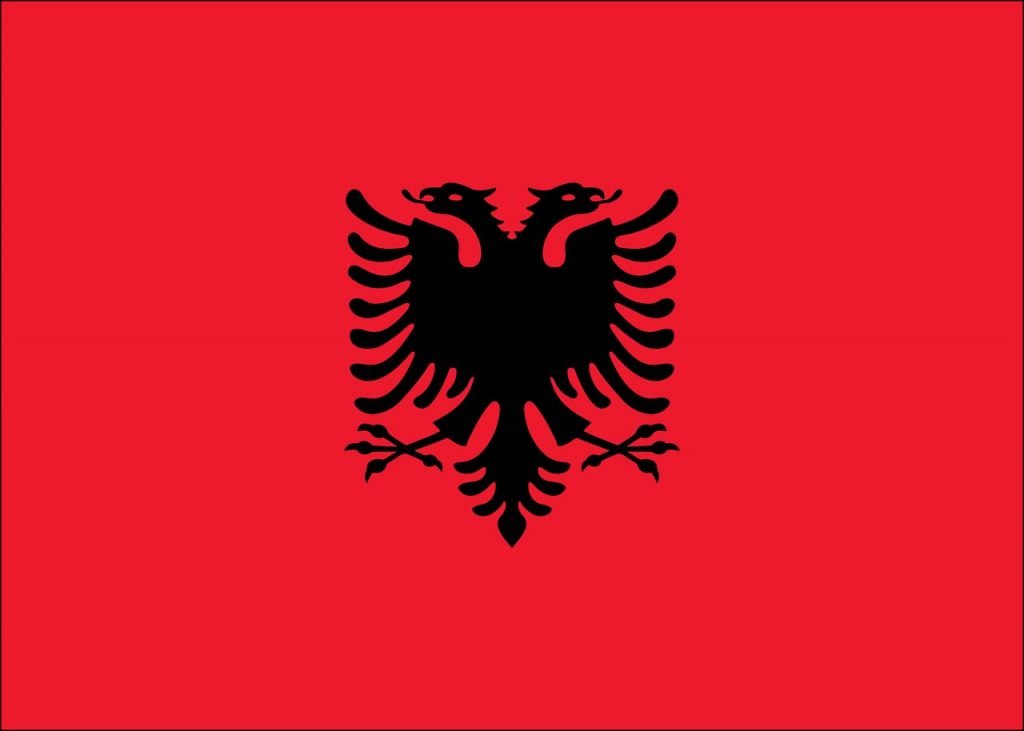
Albania Flag
The flag of Albania was adopted by the nation on independence from the Islamic Ottoman Empire in 1912. It is formed if a silhouetted, double-headed stylised eagle on a crimson background. The red field represents bravery, whilst the two-headed Eagle is an ancient symbol of the Byzantine empire and therefore has its roots in both imperial power and Eastern Christianity.
Albanian Language
The Albanian language is one of the Indo-European family, but different from its more widespread Latin Germanic and Slavonic cousins. Its closest companion by vocabulary is probably Romanian. The language is called Shqip by Albanians and Albanian by English speakers. But it’s more complicated than that. There are two principal dialects known as Geg, Tosk, and others besides.
Here are some basics. We found that an occasional halting “faleminderit” earned us big smiles in Albanian shops:
- përshëndetje (hello),
- faleminderit (thank you),
- mirë (it’s ok),
- naten e mirë (goodnight),
- mirupafshim (goodbye).
Albanian Geography
A country of mountains and lakes. 70% of Albanian territory is made up of mountains. The highest one is Mount Korab at 2,764m on the Macedonian border, making it the highest point in both countries.
There are about 250 lakes, including some resulting from ancient glaciation in past ice ages. Lake Skadar, on the border with Montenegro, is the largest lake in Southern Europe, and Lake Ohrid is believed to be one of the oldest lakes worldwide.
Of over 150 rivers in the country, only one is navigable, the 40km Bojana which connects lake Skadar with the Adriatic. The rest are too short or too mountainous to take vessels of any size.
Albanian History
Albania’s Modern history has been a rollercoaster of change and largely misery. The nation declared independence from the Ottoman Empire in 1912, but freedom was short-lived before the Italian invasion of 1939. But by the end of the War, Albania was independent again, now under Communist Loyalist control. First aligning itself with the USSR until 1960, and then for a couple of decades with China, but Albania’s paranoid dictator Enver Hoxha gradually isolated the nation from enemies and allies alike while controlling the population of his “People’s Socialist Republic” with a brutal secret police force until his death in 1985. Not until 1991 did the people of Albania achieve a multi-party democratic republic. Since then, the nation has been rebuilding itself from a position of high unemployment, corruption, and damaged infrastructure.
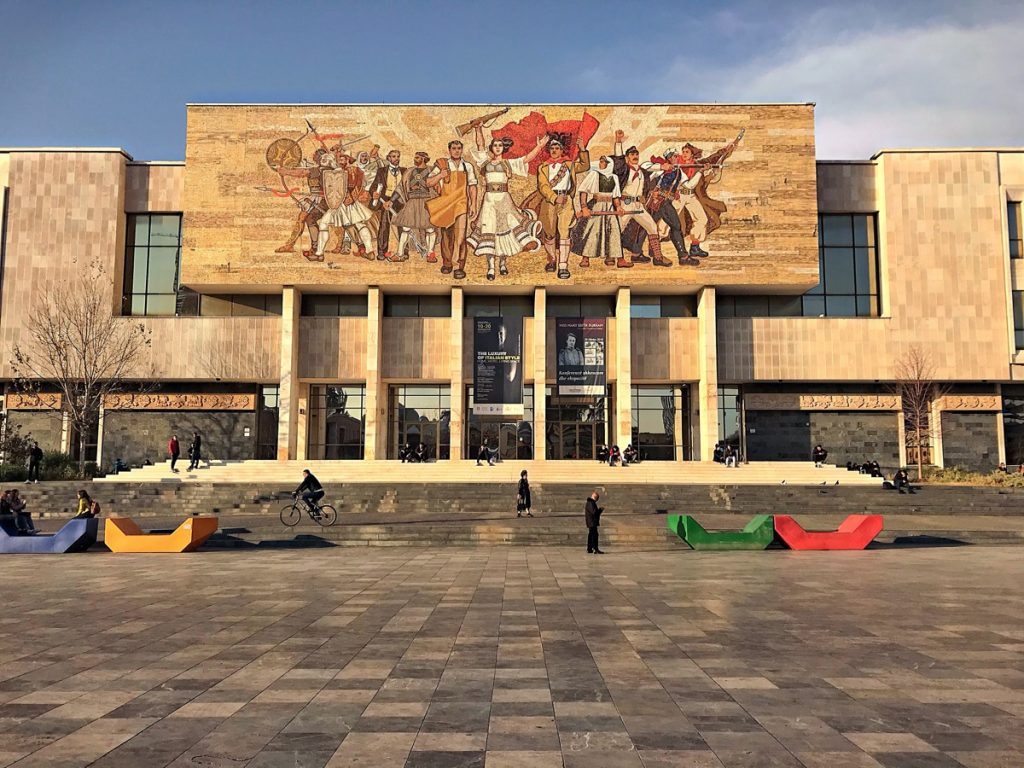
One legacy left by Enver Hoxa are 700 000 bunkers which remain across the nation, ranging from graffiti-covered machine gun pillboxes on beaches and mountain roads to the horrifying bunker in Tirana centrum converted to Bunkart2 museum.
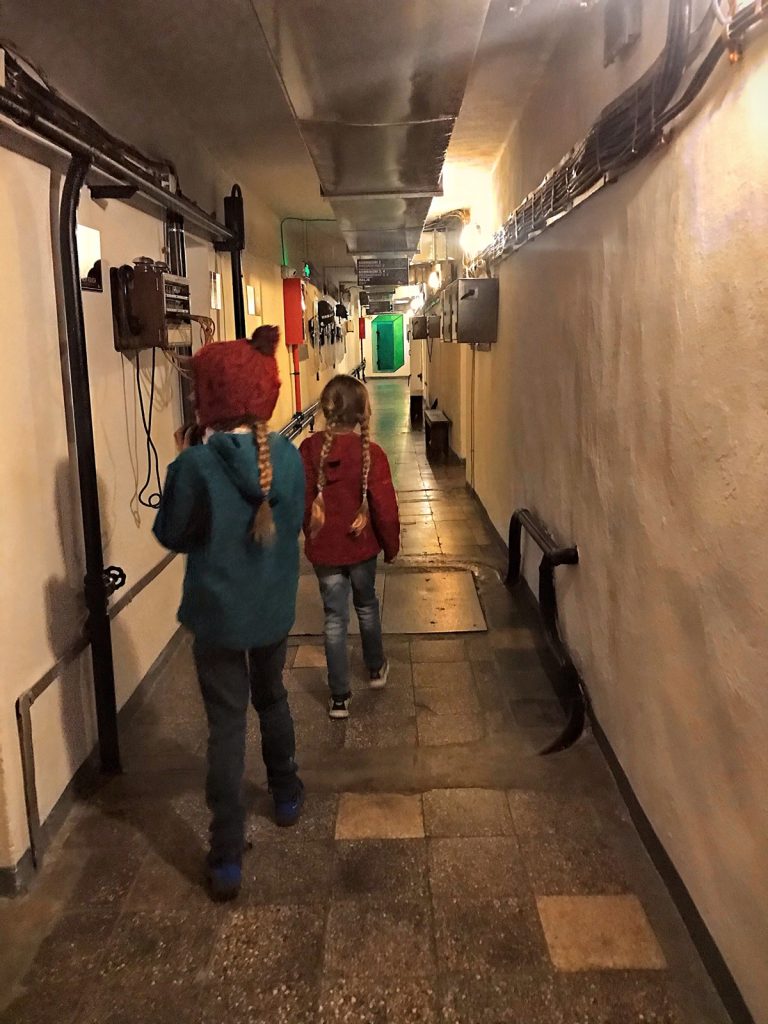
Tourism in Albania and Historic Sites
UNESCO sites in Albania
Albania has four sites inscribed on UNESCO’S world heritage list
Butrint in the south is a historical city with archaeology dating from a very well preserved Ancient Greek theatre, through Roman Byzantine Angevin and Venetian eras. The Basilica and mediaeval fortifications are some of Butrint’s most interesting features today.
The old town of Berat faces the river, and all the houses are set with their backs against the side of a rocky hillside. It is known as the city of a thousand windows, as all the buildings look forward toward the river, and indeed there must be three or four windows in every room judging from the external view. On the top of the same hill is an entire mediaeval walled town, still inhabited. This old citadel town is great to wander around with wonderful views and several restaurants, in one of which we enjoyed a lovely meal.
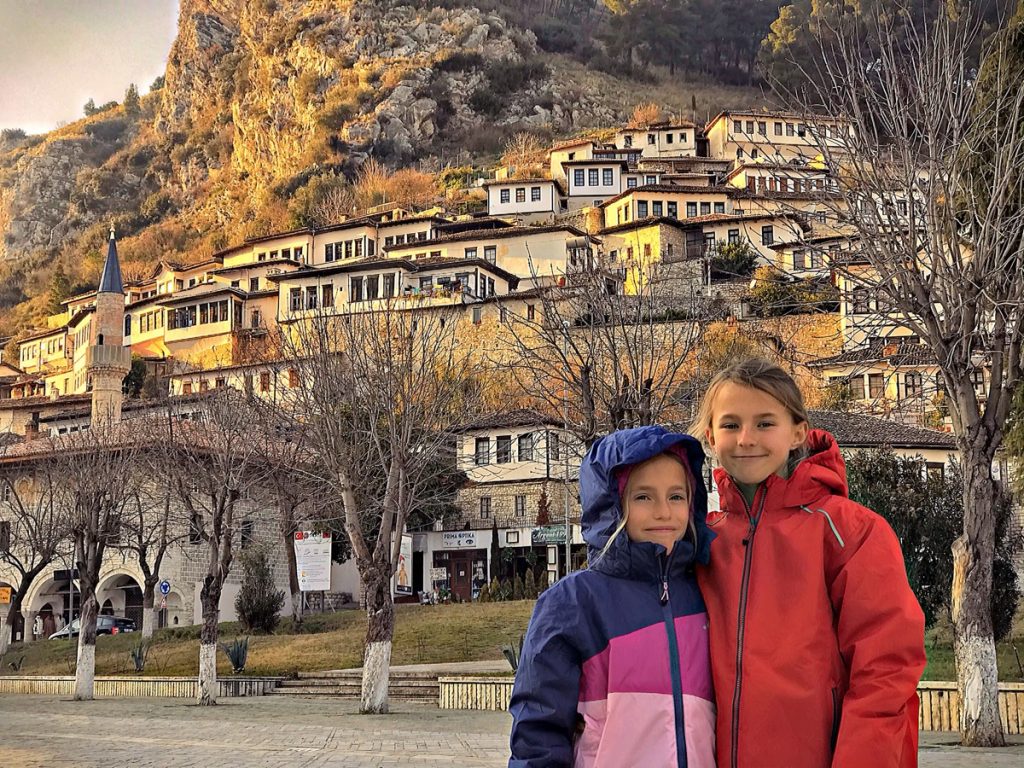
The other two sites are inscribed by Unesco for their natural features, one is an ancient Beech forest on the banks of the northern Gashi River. This which represents the post glacial European Beech forest ecosystem stretching from Ukraine in the East to Spain in the West as well as the Beskid Mountains of Poland where we have our summer home.
The Other natural site, on lake Ohrid in the east, is inscribed by UNESCO both for its natural and cultural heritage as part of the home of the Macedonian Illyrians in the fifth century BC.
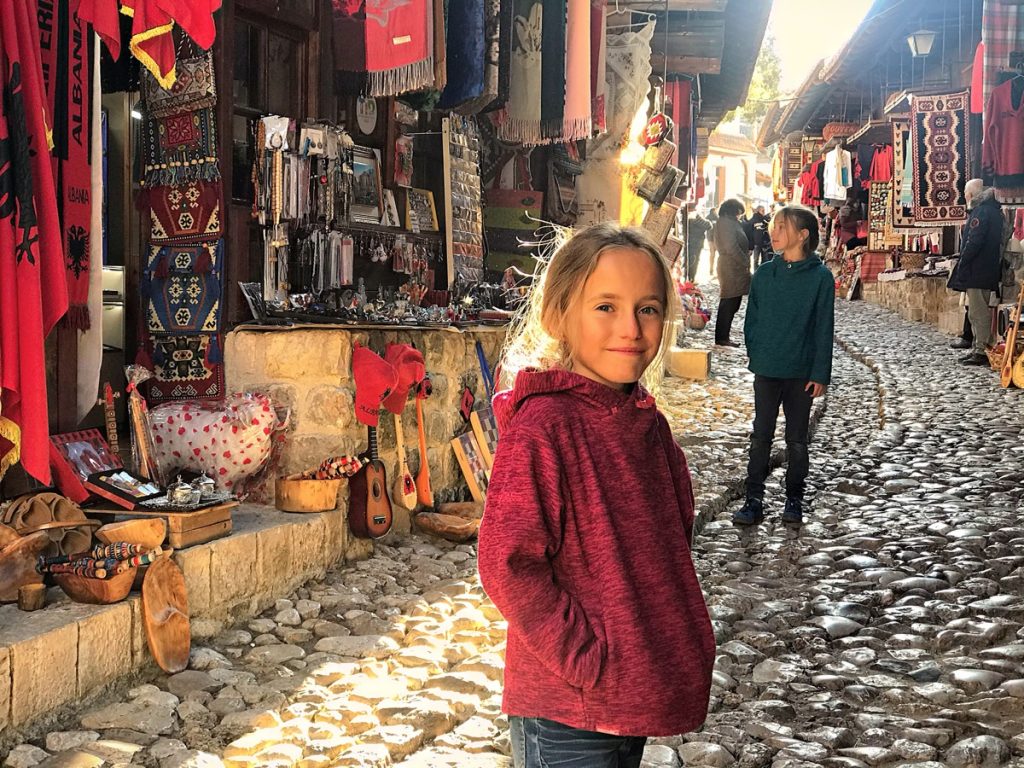
Another historic place not listed by UNESCO but which we loved is the castle of Kruja sitting on a precipitous crag and overseeing a medieval hilltown. The historic castle includes a new (20thC) tower containing the National Museum, several restaurants and most interesting for us was its ethnographic museum. Below the castle are the picturesque streets of the old market, now filled with craft workshops antique bazaars.
Albanian Beaches
Most tourists visiting Albania come for its beaches and with good reason. The Albanian Riviera, comprising the southern part of the Adriatic Sea coast, has lots of beaches offering golden sand or light pebbles, clear water and lots of sunshine. Interspersed with holiday towns with commercial hotels and agencies offering day trips are numerous tiny coves untouched by modern life. We founded that the best way to explore the country is camping in Albania.
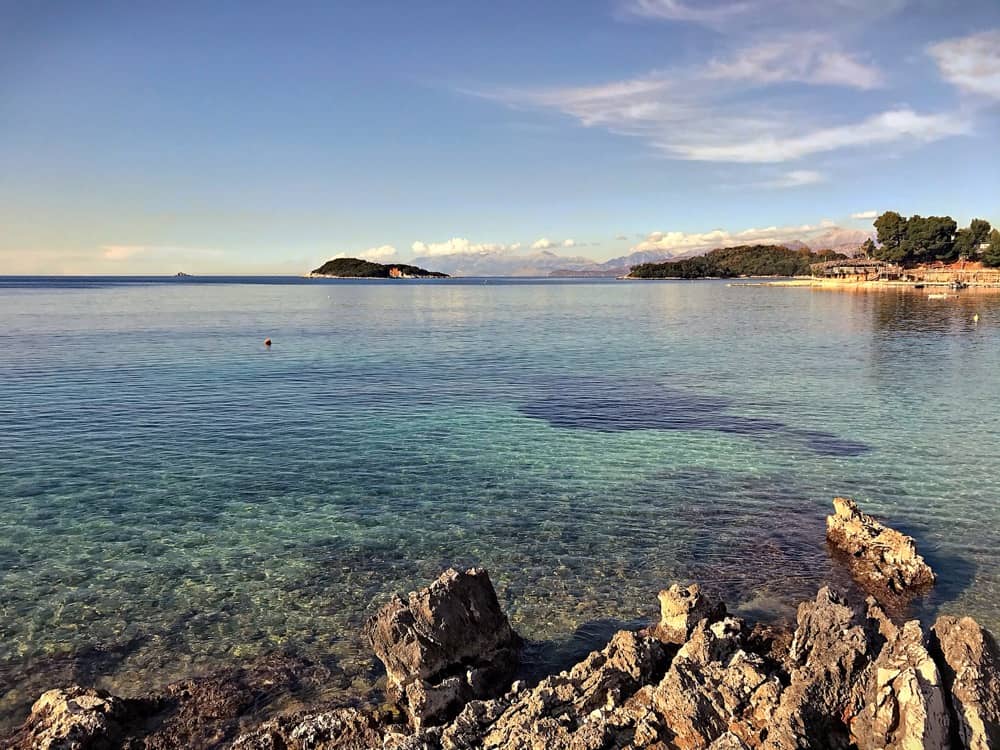
Practical considerations when coming to Albania
Albania is an agricultural country sustaining itself and exporting great produce to its neighbours, and their food is fresh and tasty – more below. Albania is one of the poorest countries in Europe with the lowest GDP per capita.
Albanian people: The people are helpful and friendly. We were surprised to discover that just about everyone speaks good English which meant we were never stranded in difficult situations.
Money in Albania: Albania is a cheap country for tourists. Double rooms in 4 star hotels can be had for €50 and meals in cafes and restaurants might cost from €5 up to €20 for something quite swish. Take cash with you though, not everywhere accepts cards. The local currency is the Lek with about 120 to the Euro, and most places take Euros. We found that ATMs prefer Visa Debit cards rather than Mastercards. ATM charges for Mastercards can be as high as €8.
Sim card in Albania: SIM Cards. Albania is not in the EU, so for us data suddenly became very expensive as we crossed the Greek border. When we arrived we used our Keepgo wifi read Keepgo review. Later we picked up a local Vodaphone SIM card in the first newsagent we found. We had to show passports and got a 15 GB SIM card for €12.
Famous Albanians
Mother Teresa:
The heroine of Calcutta known to the world as Mother Teresa was born in Skopje, which is now a part of Macedonia. Her own name was Anjezë Gonxhe Bojaxhiu. She is the only Albanian to have won a Nobel prize. Mother Teresa was canonised as a saint by the Pope on 4 September 2016

Enver Hoxha:
The Albanian dictator was born in the museum-city of Gijrokastër, Hoxha was the head of the Albanian State from 1944 to his death in 1985. He helped the country recover after its independence from the Italian invasion but became a brutal totalitarian. He cut Albania off from the world, and repressed his own people in labour camps and by executing anti-communists,
Jim Belushi:
The American actor Jim Belushi was born in 1953 in the US to Albanian parents. He graduated from Southern Illinois University Carbondale with a degree in Speech and Theatre Arts. His most famous roles include Twin Peaks (2017), Trading Places, Saturday Night Live and my favourite as child K-9
Facts about Albanian Culture
Religion in Albania
Officially 70% of Albanians are Muslim; however, we rarely saw women with their hair covered and the number who actively practice the religion is much less than that percentage. The balance declares as Christians or atheists. Albania declared itself an atheist state in 1967, making it the First Nation to do so.
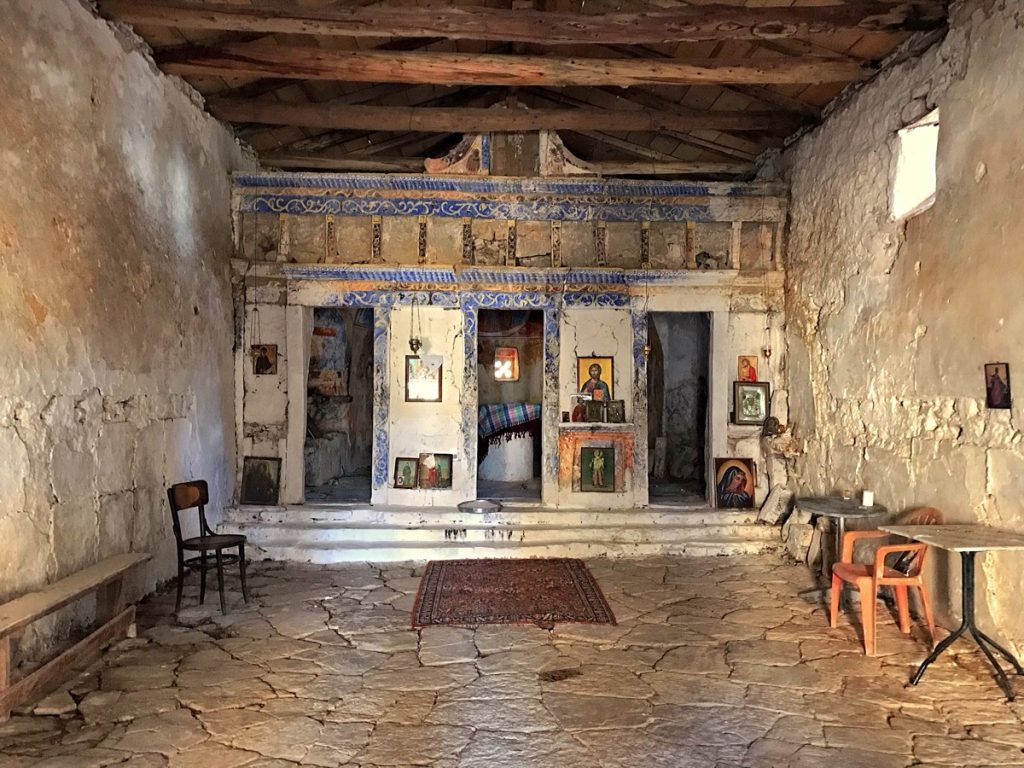
Cars and driving in Albania
Private cars were illegal in communist Albania, so before 1991 there was an average of one car per thousand people. Now there is more cars, but not all roads are up to European standards.
Yes or no
Body Language. Albanians nod for “no” and shake their head for “yes”.
Evening walks
The xhiro is the Albanian evening walk similar to the Spanish paseo. The custom is so strong that some towns close their roads to traffic at this time. It is an attractive sight to see people of all ages and both genders walking about the streets as the shadows lengthen in calm sociability with their friends and family.
Wild Animals in Albania
Albania still has wild brown bears in its forest, playing their role in preserving the natural ecology. Three wild cats include the Eurasian lynx, Balkan Lynx and European wildcat. All of them are protected as critically endangered species. The Balkan lynx is especially rare with an estimated population of fewer than 100 animals surviving in the wild.
Are Albanian Superstitious? – yes they are
- Evil Eye :The evil eye. Like Turks and Greeks, the Albanians take precautions against the evil eye.
- Stuffed Animals:You will see stuffed animals, soft toys and even scarecrows mounted outside homes and buildings to bring good luck by warding off the evil eye and envious neighbours. The talisman might be impaled on a spike or hung from a noose.
- Cutting Nails: Don’t cut your nails or pick flowers after dark. Picking flowers at night time brings bad luck while every fingernail cut in the dark is a missed opportunity.
- Spilling coffee: Spilling coffee will bring you good luck, but touching your neck might give you a sore throat.
- Stepping on your toes: If someone steps on your toes, then one of your parents will die, but you can reverse the curse by quickly stepping on the toes of the guy who just stepped on yours. Though now won’t you feel guilty when his parent dies?
- Be careful when sweeping: Take care not to sweep a broom over a child’s feet. If you do, they will stop growing. The good news is that for this one there is at least an antidote. Just touch the broom to the ceiling and blow nine short breaths in three groups of three.
- Dead mice, lice and chestnuts: Hold onto your head if you see a dead mouse, so your hair doesn’t fall out. Then having saved your hair, protect it further from head lice by taking care not to touch it after eating sweet chestnuts.
- A gift from girls: Always accept any gift offered by a young girl. If you refuse it, you may be cursing her to prevent her engagement or marriage.



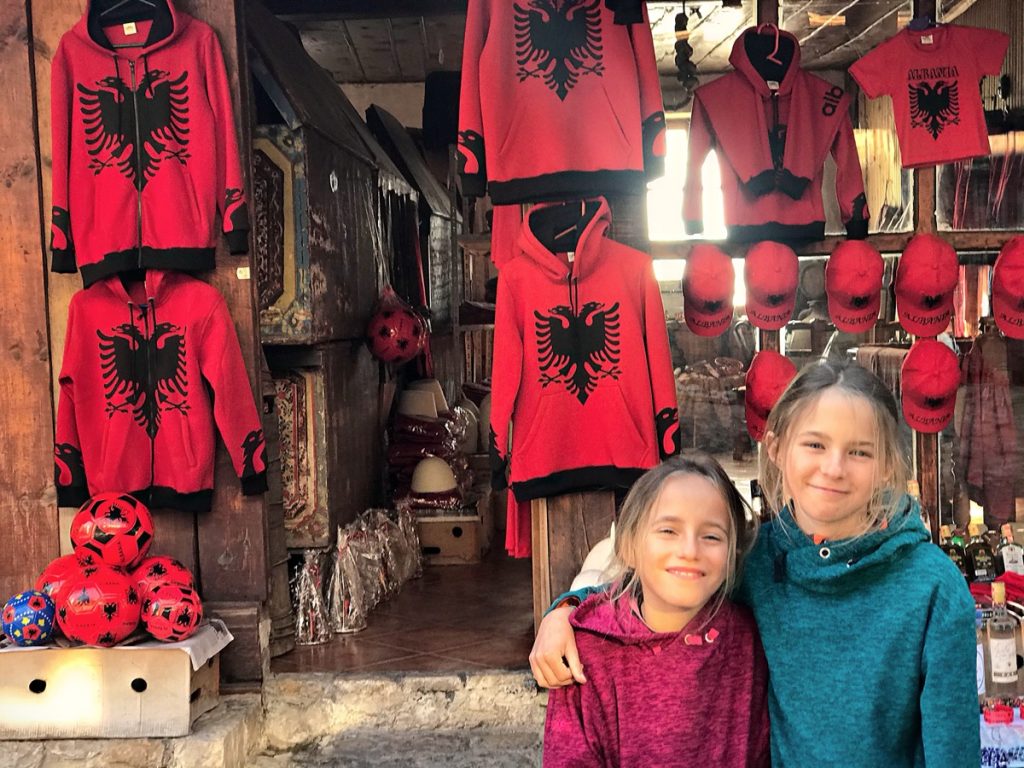
Albanian Food and Drink
- McDonald There is no McDonald in Albania. Maybe soon, but the fast food chain hasn’t landed there yet. In fact there seem to be hardly any international fast food, supermarket or coffee house chains in Albania.
- Coffee – The coffee culture is huge. Both Turkish coffee in every cafe and restaurant new and old and modern espresso coffee houses are springing up in the towns with free wifi attracting the nations cool youngsters. These coffee houses offer delicious sweets, generally much richer and more substantial than you will find in the popular chains elsewhere.
- Raki – The national drink is Raki distilled from grape remnants after making wine. Raki in both Albania and Greece is an informal cottage industry, but be warned! Village Raki is much stronger than labelled commercial spirits.
Albanian food is delicious
The food is tasty and cheap. When in Albania, try Fëgesë (a slow cooked spiced vegetable stew of peppers, onions, and tomatoes with cottage cheese), Tavë Kosi (lamb cooked with rice, yogurt and eggs), Byrek (savoury flaky pastries), Speca me Gjize (peppers with cottage cheese), and Baklava (syrup-drizzled puff pastry)
Interesting Facts about Albania – Conclusion
Known for cheap package holidays and sunny beaches Albania repays time spent in slow exploration of its rural villages, historic sites and rural villages.
Facts about Albania– Pin it for later

Privacy Policy Disclaimer
This website uses affiliate links for income and support.
If you like our website, please consider using these links. You will be directed to the vendor, and we will get a small commission on your purchase price at no increased cost to you.
We have researched facts stated here as far as practicable but please check anything critical before committing your time and money. We do not claim any special knowledge or expertise, and we are not consultants for our readers.